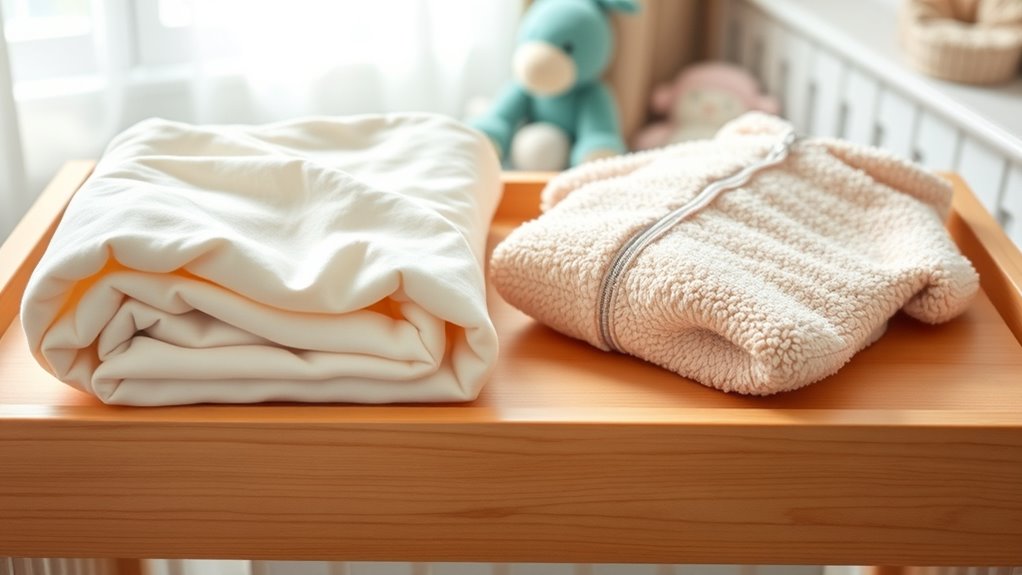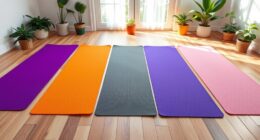Recent safety guidelines suggest that you should use swaddle blankets carefully, stopping once your baby rolls over, to prevent risks like hip dysplasia or suffocation. Sleep sacks are safer for older infants, offering a snug, secure fit without restricting hip movement. Both tools support safe sleep, but your choice depends on your baby’s developmental stage. To guarantee you’re following the latest recommendations and creating a safe sleep environment, consider the details ahead.
Key Takeaways
- Sleep sacks are generally safer for older infants and those who can roll over, reducing suffocation risk associated with loose blankets.
- Proper swaddling should snugly secure arms but leave hips loose; unsafe swaddling can cause hip dysplasia or suffocation.
- New safety guidelines recommend discontinuing swaddling once infants show developmental signs like rolling over.
- Sleep sacks eliminate risks of loose bedding, providing a safe alternative as babies grow and become more mobile.
- Choosing between swaddles and sleep sacks depends on age, developmental stage, and adherence to safe sleep practices.

When it comes to helping your baby sleep peacefully, choosing between swaddle blankets and sleep sacks can be confusing. You want to guarantee your baby’s safety while promoting healthy sleep habits, but with evolving guidelines and safety recommendations, making the right choice isn’t always straightforward. The key lies in understanding safe sleep practices and how these products support your baby’s developmental milestones.
Swaddle blankets have traditionally been used to mimic the snug feeling of the womb, helping babies feel secure and calm. However, recent safety recommendations advise caution because improper swaddling can pose risks, such as hip dysplasia or accidental suffocation if the blanket loosens. To follow safe sleep practices, if you opt for a swaddle, make sure it’s snug around the arms but loose enough around the hips to allow natural movement. Remember, once your baby reaches certain developmental milestones—like rolling over—you should stop swaddling altogether. Swaddling can inhibit the ability to roll safely, which increases the risk of suffocation if the blanket restricts movement or becomes loose.
Swaddling should be snug on arms but loose on hips and stopped once your baby rolls over.
Sleep sacks, on the other hand, have gained popularity because they are designed to eliminate loose bedding risks and support safe sleep. They provide a secure, cozy environment without the hazards associated with loose blankets. When choosing a sleep sack, look for one that fits properly—neither too tight nor too loose—and is made from breathable fabric to reduce the risk of overheating. As your baby develops and hits milestones such as sitting up or attempting to stand, sleep sacks can continue to provide a safe sleep environment, as they eliminate the need to use loose blankets that could pose suffocation risks. Additionally, understanding the contrast ratio of your sleep environment can help ensure optimal sleep conditions by controlling lighting and visual clarity.
Both options should align with current safe sleep practices, which emphasize placing your baby on their back for sleep, on a firm sleep surface, free of loose objects or bedding. It’s vital to monitor your baby’s development and shift away from swaddling at the appropriate time, typically around 2 months or once they show signs of rolling over. Doing so guarantees you’re supporting their developmental milestones while maintaining safety. Sleep sacks are often better suited for older infants because they allow for more freedom of movement and reduce the risk of accidental suffocation or entrapment. Proper baby sleep environment setup is crucial for minimizing hazards and promoting restful sleep.
Creating a safe and comfortable sleep space is essential for your baby’s well-being, and understanding developmental stages can help you adapt your sleep strategies effectively. Choosing the right sleep accessory is just one part of a broader approach to safe infant sleep. Having knowledge of safe sleep guidelines ensures you are making informed decisions that prioritize your baby’s health. Ultimately, your goal is to create a safe sleep environment that adapts to your baby’s growth and milestones. Whether you choose to continue with swaddle blankets or switch to sleep sacks, always stay informed about the latest safety recommendations. This way, you can promote healthy sleep habits and support your baby’s developmental progress while prioritizing their safety every step of the way.
Frequently Asked Questions
When Should Parents Stop Swaddling Their Baby?
You should stop swaddling your baby once they start trying to roll over or show signs of tummy sleeping, usually around 2 months old. This helps reduce the risk of suffocation or falls. Additionally, if your baby is teething and experiencing discomfort, stopping swaddling can make it easier for them to move freely and soothe themselves. Always follow current safety guidelines to make certain your baby’s well-being.
Are Sleep Sacks Safer Than Traditional Blankets?
Imagine your baby’s sleep as a gentle sailboat on calm waters. Sleep sacks act like a steady, breathable sail made of cotton comfort, allowing fabric breathability that keeps your little one cool and comfortable. Unlike traditional blankets, they fit snugly without loose fabric, reducing risks. So, yes, sleep sacks are generally safer, offering a cozy, secure environment that promotes safe, peaceful sleep without the hazards of loose blankets.
How Can I Tell if My Baby Is Too Hot in a Sleep Sack?
You can tell if your baby is too hot in a sleep sack by checking their skin temperature. Feel their neck or chest—if their skin feels hot or sweaty, they may be overheating. Watch for signs of overheating, like flushed cheeks, rapid breathing, or fussiness. Keep the room comfortably cool, and choose a lightweight, breathable sleep sack to help regulate their temperature and guarantee safe sleep.
What Materials Are Safest for Swaddle Blankets?
When choosing materials for swaddle blankets, you want safe, breathable options. Look for organic cotton, which is gentle on your baby’s delicate skin and free from harmful chemicals. Hypoallergenic fabrics are also a smart choice, as they reduce allergy risks and irritation. These materials help keep your baby comfortable and safe, ensuring they don’t overheat while swaddled. Always check for breathable fabrics to promote proper airflow during sleep.
Can I Use Both Swaddle Blankets and Sleep Sacks Interchangeably?
Sure, you can switch between swaddle blanket versatility and sleep sack customization, but tread cautiously. While both provide cozy comfort, they serve different safety purposes and developmental stages. Swaddles secure tiny limbs, while sleep sacks allow movement. Using them interchangeably may disrupt safe sleep practices. Always prioritize safety, follow guidelines, and consult pediatric advice to guarantee your little one’s sleep environment stays secure and snug, no matter the swaddle or sack.
Conclusion
Just like the wise owl of the night, choosing between swaddle blankets and sleep sacks keeps your little one safe and snug. Remember, safety is your guiding star—opt for options that promote good sleep habits without risking their comfort. Whether you opt for the gentle embrace of a swaddle or the secure comfort of a sleep sack, trust your instincts and follow the latest recommendations. After all, your vigilant care is the key to peaceful, safe slumber.









